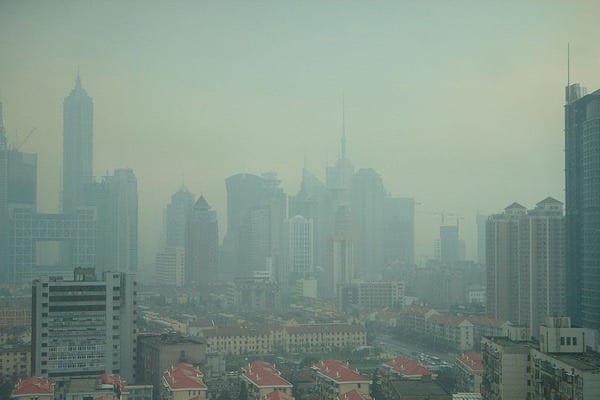
Study reveals scale of nitrogen’s effect on people and ecosystems.
It’s no secret that China is faced with some of the world’s worst pollution. Until now, however, information on the magnitude, scope and impacts of a major contributor to that pollution – human-caused nitrogen emissions – was lacking.
A new study co-authored by Stanford Woods Institute biologist Peter Vitousek reveals that amounts of nitrogen (from industry, cars and fertilizer) deposited on land and water in China by way of rain, dust and other carriers increased by 60 percent annually from the 1980s to the 2000s, with profound consequences for the country’s people and ecosystems.
Xuejun Liu and Fusuo Zhang at China Agricultural University in Beijing led the study, which is part of an ongoing collaboration with Stanford aimed at reducing agricultural nutrient pollution while increasing food production in China – a collaboration that includes Vitousek and Pamela Matson, a Stanford Woods Institute senior fellow and dean of the School of Earth Sciences.
The researchers analyzed all available data on bulk nitrogen deposition from monitoring sites throughout China from 1980 to 2010.
During the past 30 years, China has become by far the largest creator and emitter of nitrogen globally. The country’s use of nitrogen as a fertilizer increased about threefold from the 1980s to 2000s, while livestock numbers and coal combustion increased about fourfold, and the number of automobiles about twentyfold (all of these activities release reactive nitrogen into the environment).
Increased levels of nitrogen have led to a range of deleterious impacts including decreased air quality, acidification of soil and water, increased greenhouse gas concentrations and reduced biological diversity.
“All these changes can be linked to a common driving factor: strong economic growth, which has led to continuous increases in agricultural and non-agricultural reactive nitrogen emissions and consequently increased nitrogen deposition,” the study’s authors write.
The Latest Bing News on:
China’s pollution problem
- Artists in Namibia use art to promote marine conservationon May 7, 2024 at 8:30 am
WINDHOEK, May 7 (Xinhua) -- In southern Namibia, artists are using the power of art to raise awareness about the conservation and protection of the African nation's marine life along the Atlantic ...
- Single-use plastics ban is the way to solve the Philippines crisison May 5, 2024 at 4:19 pm
The Philippines can play a significant role in the global fight against plastic pollution by taking multiple measures, including banning single-use plastics. A global plastics treaty that bans ...
- The Three-Body Problem: How Chinese sci-fi went from a politically suspect niche to prized cultural exporton May 3, 2024 at 3:20 am
Despite the frictions, Chinese sci-fi remains poised to continue its international rise. Netflix’s adaptation of the “The Three-Body Problem” could bring it to a vast new audience, a coming-out orders ...
- Cows Are Just an Environmental Disasteron April 29, 2024 at 6:04 pm
And there the problem was sulfur dioxide ... So it cannot possibly be the case that we’re just offshoring all of the pollution to China if China’s pollution is also falling rapidly.
- Plastic pollution treaty would be 'failure' without tackling emissionson April 29, 2024 at 12:44 pm
Plastic production is responsible for more greenhouse gas emissions than flying – at a summit in Canada, countries were divided on how to deal with this under-recognised part of the plastic problem ...
- ‘It’s getting worse’: US failing to stem tide of harmful farm pollutantson April 29, 2024 at 9:44 am
Arnesen’s home lies near an oxygen-depleted expanse of the northern Gulf known as the “dead zone,” where dying algae blooms triggered by contaminants flowing out of the Mississippi River choke off ...
- SFC Talk | Anthony Bisseling: China's innovation and progress in science is competitive globallyon April 28, 2024 at 2:11 am
“There is an enormous increase in the publications that come from China in comparison with just 20 years ago.” Anthony was amazed by the progress made by Chinese scientists and researchers and he ...
- The Oxford-Trained Chemist-Turned-Journalist Defending Climate Capitalismon April 24, 2024 at 9:00 pm
Akshat Rathi spoke with HuffPost about the evolution of climate denialism, and what the climate crisis means for democracy.
- Pollution control improves water quality in the Yangtzeon April 24, 2024 at 6:48 pm
Editor's note: As protection of the planet's flora, fauna and resources becomes increasingly important, China Daily is publishing ... discharge made the pollution situation in the reserve even ...
- America's plastic catastropheon April 24, 2024 at 12:51 pm
America generates 40 million tons of plastic waste a year — and it can't be recycled.
The Latest Google Headlines on:
China’s pollution problem
[google_news title=”” keyword=”China’s pollution problem” num_posts=”10″ blurb_length=”0″ show_thumb=”left”] [/vc_column_text]The Latest Bing News on:
Human-caused nitrogen emissions
- The Department of Agriculture Rubber-Stamped Tyson’s “Climate Friendly” Beef, but No One Has Seen the Data Behind the Company’s Claimon May 8, 2024 at 2:01 am
As millions of taxpayer dollars flow to livestock companies claiming to raise “low carbon” beef, watchdog groups scrutinize the government’s oversight.
- Gas stoves expose millions to unsafe limits of nitrogen dioxideon May 6, 2024 at 7:29 am
Gas and propane stoves significantly increase exposure to nitrogen dioxide in rooms throughout the home, and these unsafe levels of exposure have had harmful effects on the health of tens of thousands ...
- Gas stoves expose millions in the US to unsafe limits of nitrogen dioxide, and disadvantaged communities face higher riskon May 3, 2024 at 11:02 am
Gas and propane stoves significantly increase exposure to nitrogen dioxide in rooms throughout the home, and these unsafe levels of exposure have had harmful effects on the health of tens of thousands ...
- Gas stoves expose millions in the US to unsafe limits of nitrogen dioxide, and disadvantaged communities face higher riskon May 3, 2024 at 11:02 am
Electric stoves, on the other hand, did not cause any emissions of nitrogen dioxide ... We were not meant as a human species to be breathing these toxicants in,” Dr. Kari Nadeau, chair of ...
- How safe is your gas stove? Here's what a new study shows.on May 3, 2024 at 11:00 am
“Whether you have a gas stove, or electric stove, there's very, very high justification and need for indoor settings, kitchens in particular, to have improved ventilation,” he says. “To me that has to ...
- US appeals court upholds permits for Commonwealth LNG plant on Louisiana coaston April 29, 2024 at 5:00 pm
Carbon dioxide is a primary contributor to human-caused climate change ... the law's National Ambient Air Quality Standards governing emissions of six pollutants: carbon monoxide, lead, nitrogen ...
- Nitrous oxide is one of the main greenhouse gases emitted, but where does it come from?on April 17, 2024 at 5:34 pm
Nitrous oxide is the third most significant human-caused greenhouse ... But around a third of its emissions are linked to human activity, in particular the use of nitrogen fertilizers, slurry ...
- Three Greenhouse Gases, Three All-Time Highson April 8, 2024 at 5:00 pm
Last year, humans ... caused climate change is easy to see: Many of those fires were made worse because of the warming that has already occurred. For a while, it looked like methane emissions ...
- Scientists confirm record highs for three most important heat-trapping gaseson April 6, 2024 at 9:45 am
Levels of nitrous oxide, the third most significant human-caused warming emission, climbed slightly ... has risen due to the widespread use of nitrogen fertilizer and the intensification of ...
- Farming pollutionon August 2, 2023 at 1:04 am
Modern farms produce particulate matter and gases that affect the environment and human health ... particle output, emissions of precursor gases (including sulphur dioxide, nitrogen oxides ...
The Latest Google Headlines on:
Human-caused nitrogen emissions
[google_news title=”” keyword=”human-caused nitrogen emissions” num_posts=”10″ blurb_length=”0″ show_thumb=”left”]











